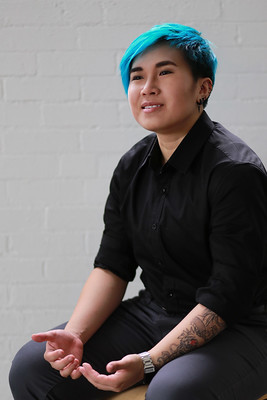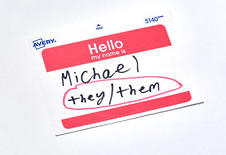
Pronouns help a writer avoid constant repetition. If there were no pronouns, we would soon be frustrated by reading sentences like "Asha said Asha was tired." A pronoun, however, can refer back to a word from earlier in the text so we don't have to repeat it: "Asha said she was tired." Since pronouns can be singular or plural and gender-neutral, feminine, or masculine, we need to make sure that we use the pronoun form that matches the word it refers to. (The word the pronoun refers to is often called the antecedent.) Pronoun agreement errors occur when the pronoun and the word it refers to do not match, or agree with each other.
| Sample sentence with a pronoun and the noun it refers to in bold | Explanation |
|---|---|
| Lani complained that she was exhausted. | She refers to Lani. Lani is the antecedent of she. |
| Kim left the party early, so I did not see them until Monday at work. | Them refers to Kim, who takes gender-neutral they/them pronouns and identifies as nonbinary. Kim is the antecedent of them. |
| Crina and Rosalie have been best friends ever since they started high school. | They refers to Crina and Rosalie. Crina and Rosalie is the antecedent of they. |

they, them, their, theirs
You may have been taught not to use "they" to refer to just one person. It has long been common in speech to use "they" to refer to one person, but for years grammarians declared it incorrect. This rule has changed in recent years. Singular they has become accepted as a way to counter sexism in language and promote inclusivity. As of 2019, the Associated Press, the Oxford English Dictionary, the Chicago Manual of Style, the MLA style manual, and the APA style manual all accept use of singular they. The MLA article "How Do I Use Singular They?" outlines the following two cases:

Correct if Shanell takes they/them pronouns: in that case, the third-person antecedent Shanell agrees with the nonbinary singular third-person pronoun they.
Correct if Shanell takes she/her pronouns: the third-person singular antecedent Shanell agrees with the third-person singular pronoun she.
If the pronoun takes the place of or refers to a singular noun, the pronoun must also be singular. Likewise, we need a plural pronoun to refer to a plural noun.
| Sample sentence with the pronouns and antecedents in bold | Explanation |
|---|---|
 If an undocumented student wants to apply for a scholarship, they can ask their college financial aid office for resources. If an undocumented student wants to apply for a scholarship, they can ask their college financial aid office for resources. | Correct: the antecedent student is singular, and the pronouns they and them are singular in this case. We use singular they to describe the student since their gender is unknown. |
 If undocumented students want to apply for a scholarship, they can ask their college financial aid office for resources. If undocumented students want to apply for a scholarship, they can ask their college financial aid office for resources. | Correct: the antecedent students is plural, and the pronoun they is plural. |
 If we want to apply for a scholarship, I can ask my college financial aid office for resources. If we want to apply for a scholarship, I can ask my college financial aid office for resources. | Incorrect: the antecedent we is plural, and the pronouns I and my are singular. |
 If I want to apply for a scholarship, I can ask my college financial aid office for resources. If I want to apply for a scholarship, I can ask my college financial aid office for resources. | Correct: the antecedent I is singular, and the pronouns I and my are singular. |
Edit the following paragraph by correcting pronoun agreement errors in number and person.
Over spring break I visited my older cousin, Diana, and they took me to a butterfly exhibit at a museum. Diana and I have been close ever since she was young. Our mothers are twin sisters, and she is inseparable! Diana knows how much I love butterflies, so it was their special present to me. I have a soft spot for caterpillars too. I love them because something about the way it transforms is so interesting to me. One summer my grandmother gave me a butterfly growing kit, and you got to see the entire life cycle of five Painted Lady butterflies. I even got to set it free. So when my cousin said they wanted to take me to the butterfly exhibit, I was really excited!
Indefinite pronouns do not refer to a specific person or thing and are usually singular. When referring to a person, use the singular they, not "he or she," as explained above. The following are some common indefinite pronouns.
| all | each one | few | nothing | several |
| any | each other | many | one | some |
| anybody | either | neither | one another | somebody |
| anything | everybody | nobody | oneself | someone |
| both | everyone | none | other | something |
| each | everything | no one | others | anyone |
| Sample sentence with the pronouns and antecedents in bold | Explanation |
|---|---|
 Everyone should do what he can to help. Everyone should do what he can to help. | Incorrect: The antecedent everyone is singular and gender-neutral. The pronoun he is singular and male. |
 Everyone should do what they can to help. Everyone should do what they can to help. | Correct: The antecedent everyone is singular and gender-neutral. The pronoun they is singular in this case and gender-neutral. |
Collective nouns suggest more than one person but are usually considered singular. Look over the following examples of collective nouns.
| audience | faculty | public |
| band | family | school |
| class | government | society |
| committee | group | team |
| company | jury | tribe |
| Sample sentence with the pronouns and antecedents in bold | Explanation |
|---|---|
 The jury has reached their verdict. The jury has reached their verdict. | Incorrect: The antecedent collective noun jury is singular, gender-neutral, and refers to an entity, not a person. The pronoun their could refer to a single person or to multiple things or people. |
 The jury has reached its verdict. The jury has reached its verdict. | Correct: The antecedent collective noun jury is singular, gender-neutral, and refers to an entity, not a person. The pronoun its is singular and refers to a non-person. |
Complete each of the following sentences by adding a pronoun that agrees with the noun it refers to.
The pronouns I and me refer to the same person, but they are different in case. I is used for the subject of a sentence, and me is used for the object of an action, as in "She helped me." Subject pronouns function as subjects in a sentence. Object pronouns function as the object of a verb or of a preposition.
| Subject pronouns | Object pronouns |
|---|---|
| I | me |
| you | you |
| he, she, it, they (gender-neutral or non-binary use) | him, she, its, their (gender-neutral or nonbinary use) |
| Subject pronouns | Object pronouns |
|---|---|
| we | us |
| you | you |
| they | them |
In the following sentences, the pronouns she and they serve as subjects:
In the following sentences, the pronouns him and it serve as objects:
Note that a pronoun can also be the object of a preposition, as in the sentence "My mother stood between us." The pronoun us is the object of the preposition between. It answers the question between whom?
Compound subject pronouns are two or more pronouns joined by a conjunction or a preposition that function together as the subject of the sentence. Compound object pronouns are two or more pronouns joined by a conjunction or a preposition that function together as the object of the sentence.
| Sample sentence with the pronouns in bold | Explanation |
|---|---|
 Me and Ananya just started learning Arabic. Me and Ananya just started learning Arabic. | Incorrect: The pronoun me is in object case but is used as part of the compound subject of the sentence. |
 Ananya and I just started learning Arabic. Ananya and I just started learning Arabic. | Correct: The pronoun I is in subject case and is used as part of the compound subject of the sentence. |
 The conversation group helped Ananya and I learn Arabic. The conversation group helped Ananya and I learn Arabic. | Incorrect: The pronoun I is in subject case but is used as part of the compound object of the verb helped. |
 The conversation group helped Ananya and me learn Arabic. The conversation group helped Ananya and me learn Arabic. | Correct: The pronoun me is in object case and is used as part of the compound object of the verb helped. |
Revise any sentences in which the subject and object pronouns are used incorrectly.
Who or whoever is always the subject of a verb. Use who or whoever when the pronoun performs the action indicated by the verb. On the other hand, whom and whomever serve as objects. They are used when the pronoun does not perform an action. Use whom or whomever when the pronoun is the direct object of a verb or the object of a preposition.
| Sample sentence with the pronouns in bold | Explanation |
|---|---|
 Who won the game last Tuesday? Who won the game last Tuesday? | Correct: The word who is the subject of the verb won, so subject case is appropriate. |
 I wonder who came up with that terrible idea! I wonder who came up with that terrible idea! | Correct: The word who is the subject of the verb came, so subject case is appropriate even though who is also the object of the verb wonder. Who is the subject within its own clause. |
 Whom did Frank marry the third time? Whom did Frank marry the third time? | Correct: The word whom functions as the direct object of the verb marry, so object case is appropriate. |
 From whom did you buy that old CD player?. From whom did you buy that old CD player?. | Correct: The word whom functions as the object of the preposition from so object case is appropriate. |
If you are having trouble deciding when to use who and whom, try this trick. Take the following sentence: "Who/Whom do I consider my best friend?" Reorder the sentence in your head, using either she or her, he or him, or they or them in place of who or whom.
The second sentence will sound wrong to experienced English speakers. So the trick is, if you can use her, him, or them, you should use whom.
Complete the following sentences by adding who or whom.
Adapted by Anna Mills from Writing for Success, created by an author and publisher who prefer to remain anonymous, adapted and presented by the Saylor Foundation and licensed CC BY-NC-SA 3.0.
This page titled 13.7: Pronoun Agreement is shared under a CC BY-NC-SA 4.0 license and was authored, remixed, and/or curated by Anonymous.